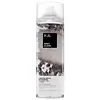What's inside
What's inside
 Key Ingredients
Key Ingredients

 Benefits
Benefits

 Concerns
Concerns

 Ingredients Side-by-side
Ingredients Side-by-side

Butane
Propane
Sd Alcohol 40-B
AstringentAluminum Starch Octenylsuccinate
AbsorbentOryza Sativa Starch
AbsorbentZeolite
AbsorbentAcrylates Copolymer
Hydrated Silica
AbrasiveCharcoal Powder
AbrasiveSodium Bicarbonate
AbrasiveMagnesium Carbonate
AbsorbentDiisopropyl Adipate
EmollientCellulose
AbsorbentHydroxyethylcellulose
Emulsion StabilisingCamellia Sinensis Leaf Extract
AntimicrobialDisteardimonium Hectorite
StabilisingButylene Glycol
HumectantPolyquaternium-59
UV AbsorberCetrimonium Chloride
AntimicrobialSodium Acetate
BufferingWater
Skin ConditioningPhenoxyethanol
PreservativeParfum
MaskingButane, Propane, Sd Alcohol 40-B, Aluminum Starch Octenylsuccinate, Oryza Sativa Starch, Zeolite, Acrylates Copolymer, Hydrated Silica, Charcoal Powder, Sodium Bicarbonate, Magnesium Carbonate, Diisopropyl Adipate, Cellulose, Hydroxyethylcellulose, Camellia Sinensis Leaf Extract, Disteardimonium Hectorite, Butylene Glycol, Polyquaternium-59, Cetrimonium Chloride, Sodium Acetate, Water, Phenoxyethanol, Parfum
Butane
Alcohol Denat.
AntimicrobialPropane
Aluminum Starch Octenylsuccinate
AbsorbentOryza Sativa Starch
AbsorbentDiisopropyl Adipate
EmollientDisteardimonium Hectorite
StabilisingLimonene
PerfumingLinalool
PerfumingTocopheryl Acetate
AntioxidantAscorbyl Palmitate
AntioxidantButylene Glycol
HumectantHelianthus Annuus Seed Extract
Skin ConditioningCitral
PerfumingHydroxycitronellal
PerfumingGeraniol
PerfumingParfum
Masking
 Reviews
Reviews

Ingredients Explained
These ingredients are found in both products.
Ingredients higher up in an ingredient list are typically present in a larger amount.
Aluminum Starch Octenylsuccinate is a synthetic powder used as an absorbent, thickener, and anti-caking agent.
As an absorbent, it is great at mattifying skin by soaking up the oil. This is why you'll find it in a range of products from makeup to moisturizers.
This ingredient is considered a modified starch. Starch can also be found naturally in plants.
One study from 1991 found that 5% of this ingredient enhanced titanium dioxide SPF by as much as 40%. The study found 1% titanium dioxide had a 5.6 SPF and adding 5% of aluminum starch octenylsuccinate boosted it to an SPF of 8.1
Although “aluminum” in an ingredient name can raise red flags for some consumers, the form and usage context matter significantly. For typical topical applications, there is no substantial evidence of health risks - such as cancer, neurotoxicity, or systemic “aluminum overload.”
Learn more about Aluminum Starch OctenylsuccinateButane is a gas derived from petroleum and natural gas. It is used as an aerosol propellant.
Butylene Glycol (or BG) is used within cosmetic products for a few different reasons:
Overall, Butylene Glycol is a safe and well-rounded ingredient that works well with other ingredients.
Though this ingredient works well with most skin types, some people with sensitive skin may experience a reaction such as allergic rashes, closed comedones, or itchiness.
Learn more about Butylene GlycolDiisopropyl Adipate comes from isopropyl alcohol and Adipic Acid.
It is a solvent and emollient. As a solvent, it is used to help other ingredients dissolve into the solution. It is also often used to soften hard ingredients.
Emollients help hydrate the skin by creating a thin barrier. This thin barrier prevents moisture from escaping.
Learn more about Diisopropyl AdipateDisteardimonium Hectorite comes from the clay mineral named hectorite. It is used to add thickness to a product.
It can also help stabilize a product by helping to disperse other ingredients.
Hectorite is a rare, white clay mineral.
Learn more about Disteardimonium HectoriteOryza Sativa Starch is an absorbent and used to mattify the skin. It is a natural carbohydrate and the main component of rice. A more common name for this ingredient is 'rice starch'.
Rice starch is created by steeping broken grains in a caustic soda.
Rice extract has many skin benefits. Read more about rice extract here.
Learn more about Oryza Sativa StarchParfum is a catch-all term for an ingredient or more that is used to give a scent to products.
Also called "fragrance", this ingredient can be a blend of hundreds of chemicals or plant oils. This means every product with "fragrance" or "parfum" in the ingredients list is a different mixture.
For instance, Habanolide is a proprietary trade name for a specific aroma chemical. When used as a fragrance ingredient in cosmetics, most aroma chemicals fall under the broad labeling category of “FRAGRANCE” or “PARFUM” according to EU and US regulations.
The term 'parfum' or 'fragrance' is not regulated in many countries. In many cases, it is up to the brand to define this term.
For instance, many brands choose to label themselves as "fragrance-free" because they are not using synthetic fragrances. However, their products may still contain ingredients such as essential oils that are considered a fragrance by INCI standards.
One example is Calendula flower extract. Calendula is an essential oil that still imparts a scent or 'fragrance'.
Depending on the blend, the ingredients in the mixture can cause allergies and sensitivities on the skin. Some ingredients that are known EU allergens include linalool and citronellol.
Parfum can also be used to mask or cover an unpleasant scent.
The bottom line is: not all fragrances/parfum/ingredients are created equally. If you are worried about fragrances, we recommend taking a closer look at an ingredient. And of course, we always recommend speaking with a professional.
Learn more about ParfumPropane is a gas derived from petroleum and natural gas. It is used as a propellant.
This ingredient is most commonly used in shaving cream, hair products, and makeup.